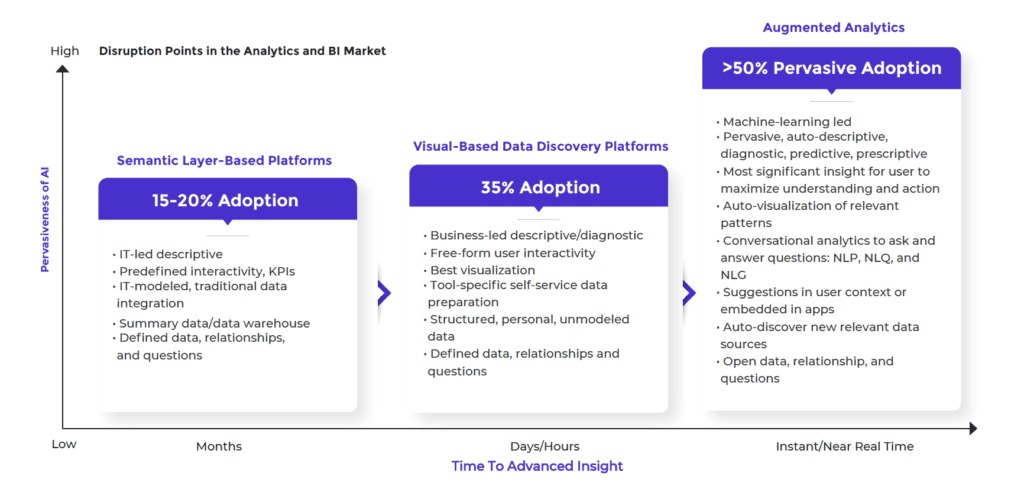 Earn with the DigitalOcean Affiliate Program or get a $200 Free Trial here 👉🏼
Earn with the DigitalOcean Affiliate Program or get a $200 Free Trial here 👉🏼
Written by Tellius » Updated on: August 27th, 2024

In the realm of business intelligence (BI), augmented analytics is emerging as a game-changer, transforming how organizations analyze data and derive insights. This innovative approach leverages advanced technologies like artificial intelligence (AI) and machine learning (ML) to enhance traditional BI processes, making data analysis more intuitive, accurate, and actionable. Here’s a look at how augmented analytics is revolutionizing the field of business intelligence.
1. Automating Data Analysis
One of the most significant advancements brought by augmented analytics is the automation of data analysis. Traditional BI tools often require manual input and complex query building, which can be time-consuming and prone to errors. Augmented analytics, however, uses AI and ML to automate these processes. By analyzing data patterns and trends autonomously, these tools can generate insights without the need for extensive human intervention. This automation not only speeds up the analysis process but also reduces the risk of human error, leading to more reliable results.
2. Enhancing Predictive Capabilities
Augmented analytics takes predictive analytics to the next level by employing advanced algorithms to forecast future trends with greater accuracy. Traditional BI often relies on historical data and static models to make predictions. In contrast, augmented analytics continuously learns from new data inputs, allowing it to refine its predictions over time. This dynamic approach provides businesses with more precise forecasts and helps them anticipate market changes, customer behavior, and potential risks more effectively.
3. Democratizing Data Access
Historically, data analysis has been the domain of data scientists and analysts, with complex tools and jargon limiting access to actionable insights. Augmented analytics is changing this by democratizing data access. Through natural language processing (NLP) and user-friendly interfaces, augmented analytics tools enable users to interact with data using everyday language. This means that business users without technical expertise can ask questions and receive insights in a more intuitive manner. As a result, decision-making becomes more inclusive, empowering employees across the organization to make data-driven decisions.

4. Improving Data Visualization
Data visualization is a crucial aspect of BI, helping users to interpret complex data sets quickly and effectively. Augmented analytics enhances data visualization by providing more interactive and dynamic visual representations. Advanced visualization features, such as real-time dashboards and customizable reports, allow users to explore data in new ways and uncover insights that may not be apparent through static charts and graphs. This improved visualization capability supports better understanding and communication of data insights, facilitating more informed decision-making.
5. Identifying Hidden Patterns and Anomalies
Augmented analytics excels at uncovering hidden patterns and anomalies within data. Traditional BI tools may struggle to identify subtle trends or outliers due to their reliance on predefined queries and static analysis. Augmented analytics, on the other hand, employs advanced algorithms to detect unusual patterns and anomalies that might otherwise go unnoticed. By revealing these hidden insights, businesses can address potential issues before they escalate and capitalize on opportunities that may have been missed.
6. Facilitating Real-Time Insights
In today’s fast-paced business environment, the ability to access real-time insights is crucial. Augmented analytics supports real-time data processing and analysis, enabling businesses to respond quickly to emerging trends and changes in the market. This capability ensures that decision-makers have up-to-date information at their fingertips, allowing for more agile and responsive business strategies.
7. Driving Strategic Decision-Making
Ultimately, augmented analytics enhances the strategic decision-making process by providing more accurate, timely, and actionable insights. With the power of AI and ML, businesses can make data-driven decisions with greater confidence, leading to improved outcomes and a competitive edge in the marketplace. By integrating augmented analytics into their BI strategies, organizations can unlock new levels of insight and innovation, driving their success in an increasingly data-driven world.
Augmented analytics is revolutionizing business intelligence by automating analysis, enhancing predictive capabilities, democratizing data access, improving visualization, identifying hidden patterns, facilitating real-time insights, and driving strategic decision-making. As organizations continue to embrace this transformative technology, they will be better equipped to navigate the complexities of the modern business landscape and achieve their goals with greater precision and agility.
We do not claim ownership of any content, links or images featured on this post unless explicitly stated. If you believe any content infringes on your copyright, please contact us immediately for removal ([email protected]). Please note that content published under our account may be sponsored or contributed by guest authors. We assume no responsibility for the accuracy or originality of such content.
Copyright © 2024 IndiBlogHub.com. Hosted on Digital Ocean